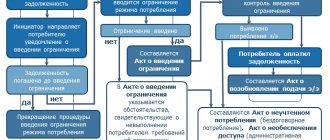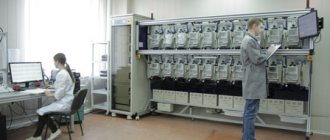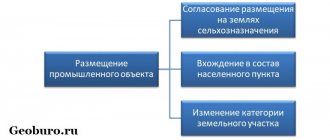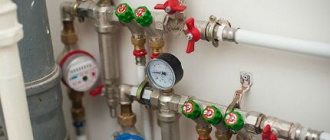The act form has been supplemented with a field for a list of measures necessary for installation of the control panel.
The results of the inspection of the technical feasibility of installing a utility meter are recorded in a report. Its form is given in Appendix 2 to Order No. 485/pr. It has undergone minor changes compared to order No. 627/pr.
As before, the act indicates who conducts the examination and in whose presence, when and where, using what tools. The fact of the possibility or impossibility of installing the meter is recorded, as well as the criteria due to which this cannot be done.
Clause 9 has been added to the act form, according to which inspectors must prescribe a list of specific organizational and technical measures that are necessary for installing a metering device, and the person responsible for their implementation.
Part of the act form from order No. 485/pr
Appendix 3 to Order No. 485/pr describes the procedure for filling out each item of the act form, which records the presence or absence of the possibility of installing a metering device in a house or premises. The sample document has remained virtually unchanged compared to the previous edition: only a paragraph has been added regarding the new clause 9 on compiling a list of activities that are necessary to install the meter and appointing a person responsible for this.
When the use of increasing coefficients affects the volume of CD on SOI
Law on communal electricity meters
Federal Law No. 261 on November 23, 2009 obligated property owners to independently install communal metering devices. If the meter was not installed before July 1, 2013, resource supply organizations do this, and the owners pay for the device and installation.
Until July 1, 2013 <...> the organizations specified in part 9 of this article are required to take steps to equip them with metering devices for the energy resources used, <...>.
A person <...> must provide access to the specified organizations to the installation sites for metering devices used for energy resources and pay the costs of the specified organizations for the installation of these metering devices. 261-FZ, Art. 12, part 13
You cannot refuse to install a meter. This is done only by objects that consume less than five kilowatts. The cost of installation is calculated in proportion to the area of the apartment or non-residential premises. When the tenant is unable to pay for the installation, the state gives an installment plan for five years, which can be repaid early.
On a note
The presence of an act on the possibility of installing a meter or its absence is important when calculating fees for utility services. So, if an act has been drawn up in relation to the premises of an apartment building stating that utility meters can be installed there, then the service provider has the right to apply an increasing factor when calculating the payment for utilities in accordance with paragraph. 3 clause 42 of the RF PP No. 354.
In this case, the fee is calculated based on the consumption standard of the corresponding utility service using an increasing factor of 1.5. At the same time, the coefficient does not increase the volume of consumption, but only the payment for it. In clause 42 and formula 4(1) of Appendix No. 2 to RF PP No. 354 there are conditions when such a coefficient does not apply:
- if the consumer has provided an inspection report regarding the lack of technical feasibility of installing the IPU, starting from the billing period in which such a report was drawn up;
- if by the legislation of the Russian Federation the obligation to equip premises in an apartment building with electrical energy meters is assigned to the guaranteeing supplier.
The new order of the Ministry of Construction of the Russian Federation did not change anything significantly in the procedure for drawing up an inspection report of a house or premises in order to record whether it is possible to install a utility meter there. But be more careful - use the new form of the act and take into account the changes that occurred after the adoption of RF PP No. 950 in the field of installation and maintenance of electricity meters: only the supplier of last resort has the right to draw up an act in relation to the PU of this utility resource.
For developers of multi-apartment residential buildings
- home
- For clients
- Electric Energy
- Information for developers
This section publishes technical requirements for equipping residential and non-residential premises of an apartment building with electricity meters and other equipment that is connected to the intelligent electrical energy metering system (ISEMS) of the guaranteeing supplier. You can also familiarize yourself with standard technical solutions for connecting electrical energy metering devices to ISUEE for developers of multi-apartment residential buildings.
Normative documents
Technical requirements were developed in accordance with Decree of the Government of the Russian Federation dated June 19, 2020 No. 890 “On the procedure for providing access to the minimum set of functions of intelligent electrical energy (power) metering systems”, taking into account the requirements of Decree of the Government of the Russian Federation dated December 21, 2020 No. 2184 “On amendments to certain acts of the Government of the Russian Federation regarding the settlement of the issue of transferring electrical energy metering devices installed by the developer to guaranteeing suppliers.” The standard technical solution option chosen by the developer must comply with the norms, rules and requirements of legal acts, state standards and technical regulations.
Application area
These requirements apply to developers of multi-apartment residential buildings who have a construction permit and design documentation for a multi-apartment residential building, issued after January 1, 2021 (according to paragraph 5 of Article 37 of the Federal Law of March 26, 2003 No. 35-FZ “On electric power industry").
General requirements
Electricity metering devices, as well as other equipment used by the developer when equipping residential and non-residential premises in an apartment building, together must ensure the possibility of their connection to the IMSUE of Uralenergosbyt LLC, as well as the reception, processing and transmission of measurement information, accounting data, control signals (commands), warning signals about the occurrence of regular and urgent events between the ISUEE measuring complex.
The version of the technical solution chosen by the developer, used when equipping residential and non-residential premises in an apartment building, must ensure guaranteed reception, processing and transmission of measurement information, accounting data, control signals (commands), warning signals about the occurrence of routine and urgent events from all measuring instruments in ISUEE Uralenergosbyt LLC.
The technologies and communication interfaces used by the developer, specifications and information exchange protocols must be ratified in the Russian Federation, open and standardized in the form of a set of unified hardware and software, methods of interconnection and interaction, as well as the behavior of functional devices for organizing communication channels (lines) and information means exchange necessary for guaranteed interconnection with the functional elements of the intelligent electrical energy (power) metering system of Uralenergosbyt LLC.
The technologies and communication interfaces used by the developer in residential and non-residential premises of an apartment building, specifications and information exchange protocols between the lower-level measuring complex, the data collection and transmission device (hereinafter referred to as the USPD) and the upper level of the ISUEE must be protected from unauthorized interference in the process of receiving and processing and transmission of measurement information, accounting data, control signals (commands), warning signals about the occurrence of regular and urgent events. Must take into account information security risks and threat assessments, provide the ability to create secure information exchange networks, in accordance with the requirements of the basic threat model published on the website of the Ministry of Energy of the Russian Federation, which defines methods for protecting information using user segmentation, identification and access authentication, as well as end-to-end encryption of communication channels (lines).
The technical solution option chosen by the developer must contain information security elements that operate before, during and after the occurrence of threats, allowing one to detect malware, network threats and timely prevent emerging threats, as well as reduce the theoretical possibilities of attacks (deliberate actions of attackers) aimed at violating any of the properties of accessibility, integrity and confidentiality installed by the developer in residential and non-residential premises of a residential building of measuring instruments and other equipment.
The choice of any technical solution option must be justified by the developer with the results of an instrumental survey of residential and non-residential premises in an apartment building, carried out for the purpose of establishing the actual values of the total power indicator of the RSSI signal received by the receiver, ensuring guaranteed reception, processing and transmission of measurement information, accounting data, control signals (commands) ), as well as warning signals about the occurrence of routine and urgent events. For technical solutions using GSM technology, the actual values of the RSSI indicator in residential and non-residential premises of an apartment building cannot be worse than -90 dBm (decibels per milliwatt).
General requirements for measuring instruments and their installation locations
Electrical energy metering devices used to equip residential and non-residential premises in an apartment building must comply with the norms, rules and requirements of the Federal Law of June 26, 2008 No. 102-FZ “On Ensuring the Uniformity of Measurements”. Must be approved for use in the Russian Federation and included in the State Register of Measuring Instruments.
Metering devices, USPD and other elements of the ISUE must comply with the requirements of the Rules for providing access to the minimum set of functions of intelligent electrical energy (power) metering systems, approved by the Decree of the Government of the Russian Federation of June 19. 2021 No. 890 “On the procedure for providing access to the minimum set of functions of intelligent electrical energy (power) metering systems.”
All elements of the ISUE must be compatible with each other and interact as a single system without restrictions on the functionality provided by the manufacturer. The ISUEE functionality must be officially supported in full by the top-level software “Pyramid 2.0”.
Individual metering devices at the facility must be of the same type and modification. Must be equipped with an optical data exchange port for connecting external mobile data collection devices (laptops, etc.). In a three-phase AC circuit, active electrical energy (power) must be metered using three-phase metering devices. All installed electricity metering devices must have seals with the initial verification mark on the screws securing the casing of the electricity metering device.
The accuracy class of current and voltage transformers for connecting calculated electricity meters must be no more than 0.5 with a verification interval of at least 16 years.
Secondary measuring circuits of current transformers are connected to electrical energy (power) metering devices separately from the secondary protection circuits. The use of intermediate current transformers to connect electrical energy (power) meters is prohibited.
The load of the secondary measuring circuits of current transformers should not exceed the rated values of the connected electrical energy (power) metering devices.
Secondary measuring circuits of current transformers must be brought out to the clamps (terminals) of pass-through test devices, ensuring short-circuiting of the secondary measuring circuits of current transformers and disconnecting for each phase of the current circuits of electrical energy (power) metering devices when replacing (checking) them, as well as turning on a model metering device without disconnecting the secondary measuring circuits of current transformers. The design of the clamps (terminals) of pass-through testing devices must ensure the possibility of their sealing.
USPDs must be equipped with an information port (optical or wired) for connecting external mobile devices (laptops, etc.).
Electricity metering devices and other equipment must be placed in a sufficiently free, easily accessible and not cramped place for maintenance in dry rooms with a temperature in winter not lower than 0°C.
Electricity meters and other equipment must be placed on panels in cabinets (panels) or in niches on walls that have a rigid structure. The height from the floor to the clamping boards (terminal blocks) of electricity metering devices and other equipment must be in the range from 0.8 to 1.7 m. A height from the floor is allowed less than 0.8 m, but not less than 0.4 m.
To place electricity metering devices and other equipment in places other than residential and non-residential premises, where there is a danger of their mechanical damage (contamination) and (or) access to them by unauthorized persons, lockable cabinets (boards) with a window at the display level must be provided ( performance indicators). Similar cabinets (boards) should also be installed for the joint placement of electrical energy (power) metering devices and measuring current transformers.
The designs, standard sizes and mounting schemes of cabinets (panels) for placing measuring instruments and other equipment must ensure the ability to:
- free and unrestricted access for maintenance personnel to the terminals for connecting electricity meters and other equipment;
- convenient installation (replacement) of electricity meters and other equipment from the front side.
When installing conductors for direct connection of electricity metering devices and other equipment, it is necessary to leave free ends of conductors with a length of at least 120 mm in front of the clamps (terminals). The insulation of conductors (phases and neutral) over a length of at least 100 mm must have distinctive conductor markings by color.
For safe installation (replacement) of electricity metering devices and other equipment in networks with a voltage of 0.4 kV, it must be possible to disconnect (relieve voltage) from all supply phases of electricity metering devices and other equipment by switching devices (fuses) installed at a distance of no more than 10 m before them. Current transformers in networks with a voltage of 0.4 kV must be installed after switching devices in the direction of power flow.
For the purposes of safe installation (replacement) and maintenance of electricity metering devices and other equipment at their locations, it is necessary to exclude the presence of open (non-insulated) live parts.
Grounding (grounding) of electricity metering devices and other equipment must be carried out in accordance with the requirements of Chapter 1.7. PUE. Grounding (grounding) conductors from metering devices and other equipment to the nearest assembly of grounding (grounding) clamps (terminals) must be made of copper.
If the automation object has several connections (inputs) with separate metering of electrical energy (power), there must be inscriptions with the names of the connections on the panels in cabinets (boards) or in niches for placing measuring instruments.
Measuring instruments and other equipment must be protected from external influences and (or) unauthorized access to exclude the possibility of interference with measurement results and (or) distortion of accounting data.
Typical technical solutions
Solution No. 1. Equipping residential and non-residential premises in an apartment building with electricity meters, as well as other equipment based on RF technologies
All instruments as part of the measuring complex (lower level) must be equipped with a universal information exchange module of RF technology (RadioFrequency), providing guaranteed reception, processing and transmission of measurement information, accounting data, control signals (commands), as well as warning signals about the occurrence of normal and urgent events on USPD*.
The exchange of measurement information, accounting data, control signals (commands) and warning signals about the occurrence of regular and urgent events between the measuring complex and the USPD is carried out using a radio frequency communication channel (line) of the permitted ISM frequency range 433.075÷434.750 MHz, 868.0÷868, 2 MHz, 868.7÷869.2 MHz or 2400.0÷2483.5 MHz. UPDs must be equipped at the input with universal RF technology receivers and transmitters, and at the output with a wired connection through an Internet provider (preferably) or multi-frequency GSM modems that support GPRS, EDGE, LTE standards, providing reception, processing and transmission of measurement information and credentials , control signals (commands) and warning signals about the occurrence of regular and urgent events. It is allowed to combine technical solutions when organizing communication between the USPD and the metering device (for example, RF + RS-485 radio channel) to reserve communication channels in order to ensure fault tolerance.
It is also possible to combine technical solutions when organizing communication between the USPD and the upper level of the ISUEE of Uralenergosbyt LLC (for example, a wired channel of an Internet provider + a GSM radio channel) to reserve communication channels in order to ensure fault tolerance.
Solution No. 2. Equipping residential and non-residential premises in an apartment building with electricity meters, as well as other equipment based on the industrial RS-485 interface
All electricity metering devices as part of the measuring complex must be equipped with universal receiver-transmitter industrial interface RS-485, providing guaranteed reception, processing and transmission of measurement information, accounting data, control signals (commands), as well as warning signals about the occurrence of routine and urgent events on USPD*. The exchange of measurement information, accounting data, control signals (commands) and warning signals between the measuring complex and the system's control unit is carried out via one organized communication channel (line) using the RS‑485 industrial interface. As a communication channel (line) between the metering devices as part of the measuring complex and the USPD, an in-house shielded cable network (common twisted pair wire bus) must be laid, through which unified discrete signals are received, processed and transmitted using the RS-485 industrial interface. UPDs must be equipped at the input with universal transceivers of the industrial RS-485 interface, and at the output with a wired connection through an Internet provider (preferably) or multi-frequency GSM modems supporting GPRS, EDGE, LTE standards, providing reception, processing and transmission of measurement information, accounting data, control signals (commands) and warning signals about the occurrence of regular and urgent events.
Solution No. 3. Equipping residential and non-residential premises in an apartment building with electricity meters, as well as other equipment based on PLC technologies
All instruments as part of the measuring complex (lower level) must be equipped with universal information exchange modules of PLC (Power Line Communications) technologies, providing guaranteed reception, processing and transmission of measurement information, accounting data, control signals (commands), as well as warning signals about the occurrence of regular and urgent events on USPD*. The exchange of measuring information, accounting data, control signals (commands) and warning signals about the occurrence of regular and urgent events between the measuring complex and the USPD is carried out via the communication channel (lines) (main). In-house low-voltage (0.4 kV) power lines must be used as a communication channel, through which unified discrete signals are received, processed and transmitted using narrow-band PLC technology and standardized specifications of the PLC, PLC-PRIME, G3-PLC network protocols. UPDs must be equipped at the input with universal transceivers of PLC technology, and at the output with a wired connection through an Internet provider (preferably) or multi-frequency GSM modems that support GPRS, EDGE and LTE standards, providing reception, processing and transmission of measurement information, credentials, control signals (commands) and warning signals about the occurrence of regular and urgent events.
* Instead of USPD, it is permissible to use other intermediate elements of the ISUE for signal conversion and transmission of measurement information, data, signals to the upper level of the ISUE.
Coordination of the selected technical solution and transfer of electricity meters into operation
The design documentation for an apartment building must take into account these technical requirements of the guaranteeing supplier.
The design documentation section must contain engineering and technical solutions, technical and functional requirements for metering devices (measuring systems), devices and equipment for data collection and transmission, internal communication systems (devices, channels, lines, etc.) ensuring mass collection and transfer of measurement information and accounting data, as well as the possibility of connecting metering devices (measuring complexes) to an intelligent system for metering electrical energy (power) in accordance with the norms, rules and requirements of the legislation of the Russian Federation on the electric power industry, ensuring the uniformity of measurements, on technical regulation and urban planning activities . The developer has the right to agree on the engineering and technical solutions he has chosen with the guaranteeing supplier, including metering devices, instrument transformers, and an internal communication system, which will be used by him in developing design documentation and equipping the apartment building.
After completing the construction of an apartment building, the developer sends a notification to the guaranteeing supplier about the need to put electrical energy meters into operation. Admission into operation of individual, common (apartment) electrical energy metering devices installed by the developer in an apartment building is carried out by the guaranteeing supplier after the network organization signs an act on the technological connection of the apartment building using a permanent power supply scheme.
Individual (common for a communal apartment) electricity metering devices in residential and non-residential premises of an apartment building, collective (common building) metering devices, instrument transformers (if necessary, install them together with collective (common building) metering devices), as well as an internal communication system (devices , channels, lines), intended for collecting and transmitting data from the specified metering devices, must be allowed into operation by the guaranteeing supplier before the developer puts the apartment building into operation.
The procedure for installing and admitting a metering device into operation ends with the drawing up of an act of admitting the metering device into operation on the basis of the form provided in Appendix No. 16 to the Technological Connection Rules. Individual, common (apartment) and collective (common building) electrical energy metering devices (measuring transformers) must be transferred by the developer for operation to the guaranteeing supplier in whose area of activity the apartment building is located, before such an apartment building is put into operation. Within 10 working days after the commissioning of all individual, common (apartment) and collective (common house) electrical energy metering devices installed in an apartment building, the developer draws up and sends for signing to the guaranteeing supplier a transfer and acceptance certificate signed on its part in two copies into operation of metering devices in accordance with the form of Appendix No. 6 to the Basic Provisions for the Functioning of Retail Electricity Markets.
ISUEE performance criteria upon acceptance
- 100% collection of all types of data from metering devices at least once a day for at least 7 days in a row;
- execution of commands received from top-level software in accordance with the functionality provided by the equipment manufacturer (control of the built-in load limitation/shutdown relay).
Until the transfer of ownership of metering devices to the owners of premises in an apartment building, responsibility for the safety of individual, common (apartment), collective (common house) electrical energy metering devices, instrument transformers, internal communication systems (devices, channels, lines) intended for collection and transmission of data from metering devices is borne by the developer.
All documentation on the facility’s ISUEE (passport forms for electricity metering devices, control devices, working drawings, diagrams, etc.) must be collected (filed) in a folder indicating the details of the facility. Documentation on ISUEE and keys to metering cabinets and electrical panels are transferred according to an acceptance certificate to a representative of Uralenergosbyt LLC.











